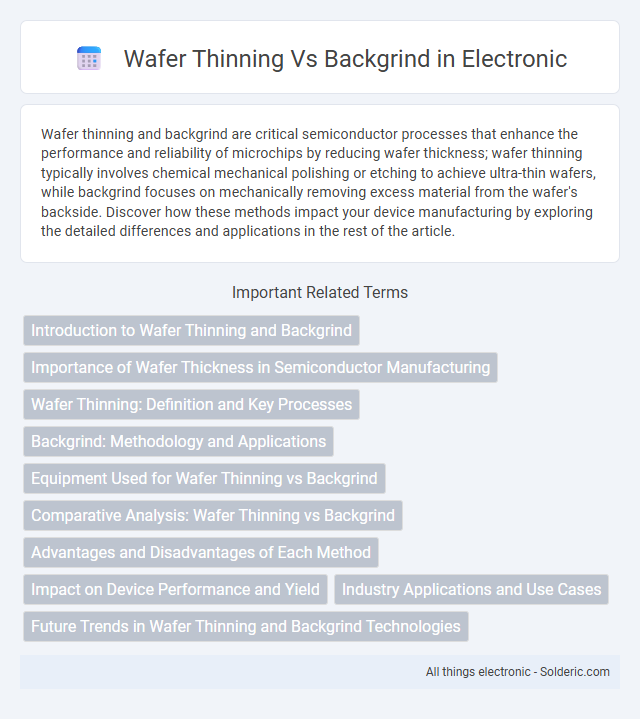Wafer thinning and backgrind are critical semiconductor processes that enhance the performance and reliability of microchips by reducing wafer thickness; wafer thinning typically involves chemical mechanical polishing or etching to achieve ultra-thin wafers, while backgrind focuses on mechanically removing excess material from the wafer's backside. Discover how these methods impact your device manufacturing by exploring the detailed differences and applications in the rest of the article.
Comparison Table
| Aspect | Wafer Thinning | Backgrind |
|---|---|---|
| Definition | Process to reduce wafer thickness by mechanical or chemical methods | Mechanical grinding process removing wafer backside material to achieve target thickness |
| Purpose | Enhance device performance, improve heat dissipation, reduce package size | Precise wafer thickness control before packaging |
| Method | Chemical etching, mechanical polishing, or grinding | High-speed mechanical grinding of wafer backside |
| Thickness Range | Typically 50-150 um, can go thinner depending on process | Usually down to 200 um or less |
| Surface Quality | Smoother after additional polishing steps | Coarser finish needing further processing |
| Risk | Possible wafer warpage or cracking if not controlled | Possible micro-cracks and damage from mechanical stress |
| Typical Applications | Advanced packaging, MEMS, flexible electronics | Standard IC wafer thinning before dicing and packaging |
Introduction to Wafer Thinning and Backgrind
Wafer thinning involves reducing the thickness of semiconductor wafers to improve device performance and enable advanced packaging techniques, crucial for compact, high-speed electronics. Backgrind is a mechanical grinding process applied to the wafer's backside to achieve precise thickness control and surface flatness, essential for enhancing wafer strength and reliability. Both processes are integral in semiconductor manufacturing, ensuring optimal wafer integrity and functionality in microelectronics.
Importance of Wafer Thickness in Semiconductor Manufacturing
Wafer thickness directly impacts the semiconductor device's electrical performance, mechanical stability, and packaging integration, making precise control critical during wafer thinning and backgrind processes. Wafer thinning optimizes heat dissipation and enables advanced chip stacking technologies, while backgrind ensures uniform thickness and surface flatness essential for high-yield manufacturing. Your choice between these methods affects device reliability, manufacturing cost, and overall process efficiency in semiconductor production.
Wafer Thinning: Definition and Key Processes
Wafer thinning involves reducing the thickness of semiconductor wafers to enhance device performance and enable application in compact electronic components. Key processes include mechanical grinding, chemical-mechanical polishing (CMP), and dry etching to achieve precise thickness control, improve surface quality, and minimize wafer stress. This technique is critical for advanced packaging, flexible electronics, and improved thermal management in integrated circuits.
Backgrind: Methodology and Applications
Backgrind is a semiconductor wafer thinning process that involves grinding the wafer's backside to achieve precise thickness and surface flatness, essential for advanced packaging and 3D integration. This mechanical grinding method uses diamond abrasive wheels to remove material while minimizing stress and potential wafer damage. Commonly applied in preparing wafers for through-silicon vias (TSVs), microelectromechanical systems (MEMS), and flexible electronics, backgrind ensures improved device performance and integration density.
Equipment Used for Wafer Thinning vs Backgrind
Wafer thinning utilizes advanced equipment such as precision grinders, chemical mechanical polishing (CMP) systems, and plasma etching tools to reduce wafer thickness uniformly while maintaining structural integrity. Backgrind processes primarily rely on high-precision backgrinding machines equipped with diamond wheels to remove excess wafer material after dicing tape application, focusing on throughput and damage minimization. Choosing the appropriate equipment depends on your manufacturing requirements, wafer specifications, and desired final thickness for optimal semiconductor device performance.
Comparative Analysis: Wafer Thinning vs Backgrind
Wafer thinning and backgrind are critical semiconductor manufacturing processes aimed at reducing wafer thickness, but they differ in precision and applications. Wafer thinning involves controlled material removal using chemical-mechanical polishing (CMP) or etching to achieve uniform thickness, ideal for advanced packaging and 3D ICs. Backgrind focuses on mechanical grinding to quickly reduce wafer thickness, often used in lower-precision applications where surface finish and damage control are less stringent.
Advantages and Disadvantages of Each Method
Wafer thinning offers the advantage of precise thickness control and reduced wafer stress, making it ideal for advanced semiconductor packaging, but it can be time-consuming and costly due to complex equipment requirements. Backgrind provides a faster, more cost-effective method for reducing wafer thickness, suitable for high-volume production, but it may cause wafer damage or introduce surface defects if not carefully managed. Your choice between these methods depends on balancing precision and cost, considering the specific demands of your semiconductor fabrication process.
Impact on Device Performance and Yield
Wafer thinning reduces substrate thickness, enhancing thermal conductivity and electrical performance by minimizing parasitic capacitance and improving signal speed. Backgrind primarily removes excess material from the wafer's backside to achieve target thickness but may induce mechanical stress, potentially affecting device yield by increasing the risk of wafer warping or cracking. Your choice between wafer thinning and backgrind impacts both device performance and manufacturing yield depending on the precision and handling during the thinning process.
Industry Applications and Use Cases
Wafer thinning and backgrind are critical processes in semiconductor manufacturing, enabling the production of ultra-thin chips essential for compact electronic devices. Industry applications for wafer thinning include mobile phones, tablets, and wearable technology where space constraints demand minimal chip thickness. Backgrind is commonly used in advanced packaging and MEMS devices to improve mechanical strength and thermal performance, ensuring your components meet stringent reliability standards in automotive and medical sectors.
Future Trends in Wafer Thinning and Backgrind Technologies
Wafer thinning and backgrind technologies are rapidly evolving to support the demand for thinner, more flexible semiconductor components essential to advanced electronics and 5G devices. Future trends emphasize the integration of plasma and laser-assisted wafer thinning methods, which enhance precision while minimizing mechanical stress and wafer damage. Innovations in real-time monitoring and automation are also driving higher throughput and yield, enabling scalable production for next-generation ultra-thin wafers.
Wafer thinning vs Backgrind Infographic

 solderic.com
solderic.com